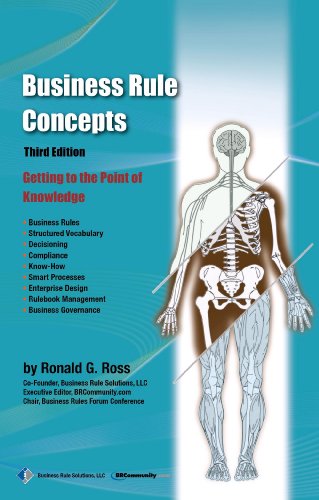Business Rule Concepts
Is your current approach really working?
Are you sure you are addressing the right problems in the right ways?
Take a few hours to read about the most fundamental innovation in business operations and business computing in decades. It is not just about IT any more!
Decisioning, Requirements, Governance, Knowledge.
Radical in its simplicity, this concise, easy-to-read handbook presents a groundbreaking, common-sense approach to solving today’s operational business problems. Find out why current IT methods have broken down and no longer scale.
Written by the father of business rules, here are proven answers. Get your company on the road to true agility!
New this Edition …
* Decisioning
* Capturing best practices
* Enterprise design
* Really smart systems
* Building business vocabularies
* Structured verbalization for business communication
* Applied semantics and concept analysis
* Re-engineering governance
Introducing … General Rulebook Systems (GRBS)
Plus all you need to know about …
* Business rules
* Forms of business guidance
* Fact models
* Applying SBVR
* Innovations in compliance
* More effective process models
* Pragmatic knowledge retention
* Rule management
Content: The book is divided into four main parts:
Part 1: The Key Ideas … aimed toward the general reader seeking to understand the basic ideas of the business rules paradigm. It starts with business vocabulary, moves on to business rules, and concludes by discussing implications for the business manager or project leader. The better your company gets at business rules and rule management the better it can become at the nuts and bolts of governance. The goal – smart governance.
Part 2: Business Vocabularies and Fact Models … all about business vocabularies and fact models i.e., semantic structure. Part 2 discusses how to build a well-organized business vocabulary and to represent it as a graphical fact model. Fact models serve many important purposes other than simply design of data models or class diagrams, especially to express business rules, IT requirements, and other forms of business communication. So the discussion picks up with verbalization.
Part 3: Business Rules … examines business rules in depth. The emphasis is on capture and communication of business rules in a form that is business-friendly yet robust. It explains the difference between business rules versus data or system rules. It also examines the surprising relationship between business rules and events. You will be guided through all the important things you need to know about business rules and their implications for business analysts.
Part 4: Enterprise Design … explores the role business rules play in smart architectures, smart knowledge management, smart (simpler) business processes, and smart (really smart) systems. It examines point of knowledge, a real place the place where business rules happen. It explains how real-time compliance, continuous learning, and worker empowerment are a three-in-one solution. In closing, you are invited to probe the leading edge in achieving really thin, really agile, really dynamic (indeterminate) processes.
Leave a Comment
You must be logged in to post a comment.







